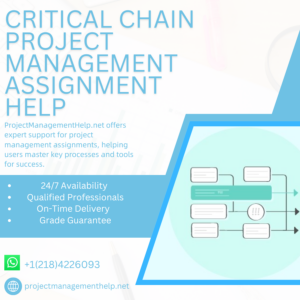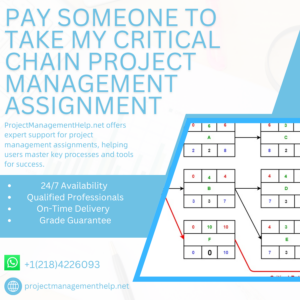How do I get help with my CCPM final project?
How do I get help with my CCPM final project? Hi! My main problem are three things: when you build
Critical Chain Project Management (CCPM) is a method that oversees essential resources and prioritizes tasks dependent on them, helping projects finish on schedule and within budget.
To use CCPM, start from your goal and work backward to determine what steps will help get there. This method enables planners to more accurately estimate project resources needed and required.
Project Network Diagrams are invaluable tools for visualizing dependencies and tracing the longest path through multiple tasks, helping identify critical paths as well as potential alternative routes that might fit within your time constraints and schedule. They show task duration as well as their earliest start times – invaluable information that is often overlooked during project planning!
Contrary to the critical path method, which seeks an ideal schedule, CCPM acknowledges that most Projects won’t complete on schedule. It operates on the idea that events can be likened to an relay race where athletes work in sequence to bring a baton across the finish line.

This approach utilizes the work breakdown structure to identify interdependent tasks and their durations, which is required for creating a project network diagram. Furthermore, this approach includes feeding chain, additional dependent activities chain as well as buffers of resources and feedings in order to monitor project’s progress more easily.
Contrary to other project management methodologies, CCPM challenges the traditional wisdom of adding extra time between tasks for buffers. Instead, it promotes ambitious but reasonable task estimates and removes redundant buffer periods to increase efficiency while encouraging urgency and accountability among team members while also cutting costs, increasing productivity, and speeding up projects.
As part of their methodology, project team members often underestimate task durations, making it challenging to monitor progress using other tools like burn down charts. With PMPortal critical chain project management assignment help Tool you can easily track task durations as well as create monitoring charts using your data.
Tracking task completion rate vs. critical path can help you understand risk of project delays and pinpoint areas for improvement, while monitoring resource usage like team members and physical resources with this tool.
Buffers are at the core of Critical Path Project Management (CCPM), allowing planners to track project progress. A relay-race approach to workflow management, it aggregates safety into strategically placed buffers to protect critical paths from delays; each time an unanticipated task takes longer than anticipated, some of this buffer protection is consumed.
CCPM also eliminates any slack in task duration estimates, as over-provisioning and delays can arise from overly optimistic estimates. By using project buffers to ensure key tasks finish on time, this methodology encourages urgency and accountability among team members while improving project performance overall.
The Critical Chain Project Management (CCPM) method also emphasizes resource constraints, while offering feeding chains that can accommodate delays without impacting critical chain tasks. Each of these feeding chains have feeding buffers designed to give teams additional time for tasks not considered part of critical path projects; typically these feeding buffers are calculated using 50% of safe estimate for task sequences.
Buffers serve to safeguard project completion dates by permitting you to delay one task in the critical chain without impacting other tasks, without altering schedule or resource leveling efforts. They’re usually added after resource leveling has taken place to prevent schedule rigidity from developing too rapidly; project planners add feeding buffers before dependent chains merge with critical chains, and resource buffers warn participants they may require additional resources.
Teams can work more efficiently by eliminating wasteful safety precautions from individual tasks and pooling it into strategic buffers. A transparent project schedule encourages accountability as employees know that their output will be evaluated against results from across the chain.
Goldratt also rejects multitasking, or planned procrastination, by Team members and advocates creating urgency within teams by making tasks more urgent. This strategy helps increase productivity and lead times while instilling ownership in projects; NASA and Air Force use this method at Langley research facilities while manufacturers of appliances, pharmaceuticals, aircraft parts and automotive parts also utilise it.
Students often struggle to find time for studying and completing assignments on time due to work commitments; therefore, Academic writing help services play a crucial role in getting assignments completed on schedule.
This course will introduce the Critical Chain Project Management (CCPM). You will explore its differences from traditional approaches.

Critical Chain Project Management (CCPM) offers an innovative approach to project management. Comparable to a relay race, its primary objective is monitoring essential resources as the project unfolds; buffers provide extra protection from delays and budget overruns. Marris Consulting’s Philip Marris discussed its application using this methodology for decreasing aircraft maintenance downtime by employing this strategy.
CCPM involves using critical path to create a schedule, then including time buffers in your plan in order to protect each task’s due dates from delays that might arise unexpectedly during implementation. Its basis lies within Eliyahu M. Goldratt’s 1997 book Critical Chain and his Theory of Constraints concept.
Next step should be allocating resources for each task on the critical path, whether these include equipment, Physical space or human resources. Be mindful of any restrictions such as labor regulations or team members taking time off for vacation; resource leveling allows CCPM practitioners to adjust start and end dates of tasks so as to spread out demands across individual resources more evenly.
Choose an academic writing company with experience to save both time and money. Top academic writing services provide term paper writing, essay writing, research papers as well as secure payment systems and take accountability for their work.
PapersOwl is a reliable writing service with an exceptional track record in providing high-quality content at affordable prices – something customers have recognized through customer reviews of this writing service. Customers have consistently given them rave reviews as it quickly responds to inquiries, issues and requests for help (e.g. “write my essay”). Their dedication to providing top-tier writing has established an industry leadership status among clients.
Apart from other Writing services by offering students the option of selecting their own writer. This ensures a more customized approach, meeting students’ expectations with every assignment produced. Furthermore, students can upload unlimited attachments and communicate directly with their writers to improve quality writing output.
Critical Chain Project Management stands out from other project management methodologies by emphasizing resources. Critical Chain Project Management takes into account any resource constraints or buffers that might delay completion. For instance, an employee taking 10 days normally to finish designing an item could take longer if they take an unexpected trip during that period – this would constitute a resource constraint and potentially delay project completion; early identification can help avoid these delays and issues.
Reliable employees understand the significance of meeting deadlines, and any failure would have serious repercussions for their employers. They also tend to be effective planners who prioritize tasks effectively – never overestimating or underestimating situations; and always taking an objective, realistic approach towards their work.
Validity refers to Tests or experiments which produce consistent, reliable results that accurately reflect their target trait – for instance if testing problem-solving skills, reliable tests should produce identical results every time.
Student who pay for academic writing help services must understand how the pricing structure works in order to get assistance without breaking their budget. Prices typically depend on factors like number of pages and due date; other services provide flat rate pricing that could prove helpful if students require assistance with critical chain project management assignments.
CCPM, or Critical Chain Project Management, utilizes focused durations to reduce project duration and improve on-time performance. It is commonly employed by organizations that manufacture products like appliances, pharmaceuticals or aircraft.
Critical Chain is distinct in that it acknowledges that project execution relies on people, not computers. Human nature often results in the opposite of what was intended – tasks expand to fit within the time available, distractions arise and delays become unavoidable. To prevent such issues from arising, Teams should focus on keeping to their critical path while minimizing distractions by eliminating unnecessary meetings or interruptions and optimizing resource use by delegating non-critical tasks to other team members.
Critical Chain Project Management (CCPM) has quickly become one of the cornerstones of general project management Practices, emphasizing resource limitations, constraint identification and schedule predictability.
CCPM utilizes time buffers to account for human errors in estimating task durations. These buffers are strategically inserted into critical path and feeding chains as an attempt at avoiding rework.

When selecting a writing service, quality is of utmost importance. This includes creating your essay from scratch using proper formatting and language; they should also have an anti-plagiarism policy in place to protect against plagiarism.
The Critical Chain Project Management (CCPM) methodology is a network Analysis technique for schedule network analyses that takes into account task dependencies, resource constraints and buffers. Based on Eliyahu Goldratt’s Theory of Constraints theory first presented in 1997.
Reputable writing services not only ensure quality work, but they will also protect both your privacy and academic reputation. This means they won’t share your personal information with third parties, they use end-to-end encryption on their websites and client-writer chats, offer money-back guarantees if the final product falls short, and won’t reuse essays written by other customers – thus guaranteeing that each essay written for you will be unique and original.
As its name implies, Critical Chain Project Management (CCPM) centers around identifying the critical chain, or long chain of tasks required to complete a project. It takes into account both task dependencies and resource constraints when developing this method of planning.
This method also reduces nonproductive multitasking, leading to faster project completion times, higher quality deliverables, and enhanced team spirit. Furthermore, this provides a clearer view of your shop’s true capacity, helping optimize resource usage while preventing schedule delays.
Process begins by identifying all work that needs to be completed and making aggressive time estimates for each task. After this step has been taken, project planners can locate critical paths and add buffers as contingencies against any unforeseen events which might disrupt overall project completion dates. PMI research shows that projects using this approach complete up to 25% faster due to additional resource buffers being included within estimates times.
Failure of any project typically stems from three issues: it’s late, over budget or below specification and quality. One primary reason for this failure lies with resource issues – misusing them or running out altogether – preventing projects from being completed on schedule. Critical chain project management seeks to mitigate such difficulties by helping businesses monitor and prioritize key resources more closely.
This technique integrates critical path and feeding chain analysis with resource-leveled task schedules and pooled contingency plans in order to more effectively address resource uncertainty. Buffers help prevent student syndrome (delaying starting tasks until the last minute) and Parkinson’s Law (task duration estimates inflating over time), as well as encourage teams to stay focused on individual tasks for an efficient relay race mindset.
As part of any successful project, it’s vital that businesses identify all the work required and map it out before moving forward with the project. Once completed, identify specific resources necessary, such as materials, tools, labour and specialists skills required – this will also allow businesses to identify any possible constraints early so they can plan accordingly.
How do I get help with my CCPM final project? Hi! My main problem are three things: when you build
Who can do my Critical Chain Project Management coursework? At least you haven’t told me! Gabe’s first coursework will be
Where can I find reliable CCPM assignment help? Hi people – Thanks for your feedback – always glad to hear
Can I pay someone to write my CCPM literature review? I would love to pay someone to do it for
How do I find a CCPM tutor to take my test? I was told to find a tutor to begin
Who can help me finish my Critical Chain Project Management dissertation? You can try writing a project for which you
Can someone write my CCPM presentation for me? It was great to see you take this opportunity to give you
Where can I get assistance with my CCPM capstone project? I am pretty new to these kinds of questions, but
How do I get help with my Critical Chain Project Management exam? There is a lot of book reviews dedicated
Can I pay someone to do my CCPM essay?. RENEAX is a full thesis essay and a full thesis to
ProjectManagementHelp.Net provides expert assistance for project management assignments, offering guidance and solutions to students and professionals.

![]()

Copyright © All rights reserved | ProjectManagementHelp.Net